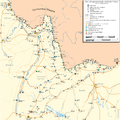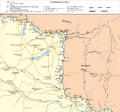Limes (Roman Empire) facts for kids
| UNESCO World Heritage Site | |
|---|---|

The limes Germanicus, 2nd century
|
|
| Location | The valleys of the Rhine and the Danube; Britain. |
| Includes | Hadrian's Wall, Roman defenses along the Cumbrian coast, and the Limes Germanicus; the Antonine Wall is a later addition to this site |
| Criteria | Cultural ii, iii, iv |
| Inscription | 1987 (11th Session) |
| Extensions | 2005, 2008 |
| Area | 526.9 ha |
| Buffer zone | 5,225.7 ha |
The Limes (pronounced LEE-mes) was a huge system of borders and defenses built by the Roman Empire. It helped protect the Roman lands from outside attacks. Even though the Romans didn't use the word Limes for their borders, it's a modern term that helps us understand these ancient defenses.
Today, the term Limes also includes other Roman border defenses, like the famous Hadrian's Wall and the Antonine Wall in Britain. These walls and other parts of the Limes are now recognized as a World Heritage Site by UNESCO, showing their importance in history.
Contents
The Roman Limes: Protecting an Empire
The Limes was more than just a wall. It was a complex system of forts, watchtowers, ditches, and sometimes even palisades (wooden fences). It marked the edge of the Roman Empire, where Roman control was strongest. However, it also included areas nearby where the Romans kept a close watch with their soldiers.
What Was the Limes For?
The main purpose of the Limes was to control who and what came into the Roman Empire. It wasn't always about stopping huge armies. Often, it was used to:
- Control trade and collect taxes on goods.
- Prevent small raids from tribes living outside the empire.
- Keep an eye on movements of people and groups.
- Show the power and reach of the Roman Empire.
Different Parts of the Limes
The Limes stretched across many different regions. Each part was built to suit the local land and threats.
The Germanic Limes
One of the most well-known parts was the Limes Germanicus in what is now Germany. This section was a long line of defenses that included:
- Wooden or stone watchtowers.
- A ditch and an earth bank.
- Sometimes a wooden palisade or a stone wall.
- Many forts where Roman soldiers lived and trained.
These defenses helped protect the Roman provinces of Germania Inferior and Germania Superior from Germanic tribes.
The British Walls
In Britain, two major walls were part of the Limes system:
- Hadrian's Wall: Built by Emperor Hadrian, this stone wall stretched across northern England. It had forts, milecastles (small forts every Roman mile), and turrets (watchtowers). It was a strong barrier against tribes from the north.
- Antonine Wall: Built later by Emperor Antoninus Pius, this wall was further north in Scotland. It was mostly made of turf (earth and grass) with a deep ditch. It was held for a shorter time than Hadrian's Wall.
The African Limes
The Romans also built defenses in North Africa, known as the Limes Africanus. These were different from the European walls because they often used natural barriers like deserts. They included:
- Forts and watchtowers in strategic locations.
- Long ditches, like the Fossatum Africae, which helped control movement and water.
- These defenses protected Roman settlements and trade routes from nomadic tribes in the desert.
Life Along the Limes
Life for Roman soldiers and civilians along the Limes was unique. Soldiers spent their days patrolling, training, and building. They often came from different parts of the empire, bringing their cultures with them. Towns and villages grew up around the forts, where traders, craftsmen, and families lived. This created a mix of Roman and local cultures.
The Limes was not just a military line; it was also a place of cultural exchange. People from both sides of the border interacted, traded, and sometimes even settled.
Images for kids
-
Map of fortifications and castles in North Britain around 155 AD (most forts on and south of Hadrian's Wall have been omitted).
-
Limes Africanus under Septimius Severus (The frontier of Roman Africa (dark tan) in the late 2nd century AD: Septimius Severus expanded the Limes Tripolitanus dramatically (medium tan), even briefly holding a military presence (light tan) in the Garamantian capital Garama in 203)
See also
 In Spanish: Limes para niños
In Spanish: Limes para niños












